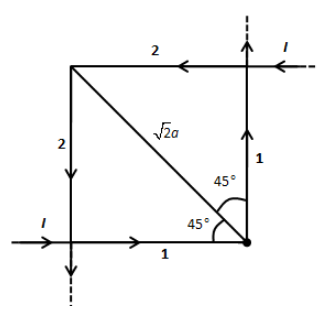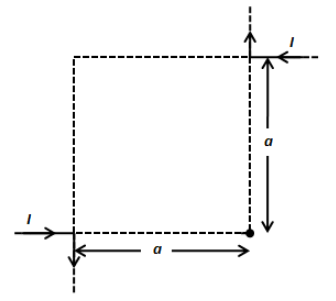Answer
385.8k+ views
Hint:The magnetic field at point P due to lower wire will be zero since the point lies on the wire. Use Biot-Savart’s law to determine the magnetic field due to a finite wire at a point P which is at a distance r from the wire. Use the right-hand thumb rule to determine the direction of the magnetic field.
Formula used:
\[B = \dfrac{{{\mu _0}I}}{{4\pi d}}\left( {\sin {\theta _1} + \sin {\theta _2}} \right)\]
Here, \[{\mu _0}\] is the permeability of free space, I is the current, d is the distance of point from the wire, \[{\theta _1}\] and \[{\theta _2}\] are the angles made by the wire with point P.
Complete step by step answer:
We can see in the given current distribution, the current forms a rectangle. Let the current through wire 1 is such that the point P is on the wire 1 and the wire 2 makes an angle \[45^\circ \] to the point P as shown in the figure below.

The magnetic field at point P due to wire 1 will be zero since the point lies on the wire 1.
Let us calculate the magnetic field due to wire 2 whose one end is infinite and another end makes an angle \[45^\circ \] to the point P. If we consider the horizontal and vertical section of wire 2, then both sections are making the angle \[45^\circ \] to the point P. The magnetic field at point P will be the addition of magnetic fields due to current in both sections of wire
2. Therefore, the current will be twice of I that is \[2I\].
Using Biot-Savart’s law, the magnetic field at a point P due to current carrying wire, we have,
\[{B_2} = \dfrac{{{\mu _0}I}}{{4\pi r}}\left( {\sin {\theta _1} + \sin {\theta _2}} \right)\]
Here, \[{\mu _0}\] is the permeability of the free space.
Substituting \[I = 2I\], \[r = \sqrt 2 a\], \[{\theta _1} = 45^\circ \] and \[{\theta _2} = 90^\circ \] in the above equation, we get,
\[{B_2} = \dfrac{{{\mu _0}2I}}{{4\pi \left( {\sqrt 2 a} \right)}}\left( {\sin \left( {45} \right) + \sin \left( {45} \right)} \right)\]
\[ \Rightarrow {B_2} = \dfrac{{{\mu _0}2I}}{{4\pi \left( {\sqrt 2 a} \right)}}\left( {\dfrac{1}{{\sqrt 2 }} + \dfrac{1}{{\sqrt 2 }}} \right)\]
\[ \Rightarrow {B_2} = \dfrac{{{\mu _0}2I}}{{4\pi \left( {\sqrt 2 a} \right)}}\left( {\dfrac{2}{{\sqrt 2 }}} \right)\]
\[ \Rightarrow {B_2} = \dfrac{{{\mu _0}I}}{{2\pi a}}\]
Now, let us determine the direction of the magnetic field at point P due to wire 2. We have from Right-hand thumb rule, if we hold a current carrying conductor in our right hand such that the thumb points in the direction of current; then the curled fingers around the conductor denotes the direction of the magnetic field. Thus, we can see that the curled fingers at point P points outward from the page. Therefore, the direction of the magnetic field is out of the page.
So, the correct answer is option B.
Note: We have determined the magnetic field due to whole wire 2 which is bent perpendicular along its length rather than determining the magnetic field due to each horizontal and vertical section of the wire. The magnetic field at a point lying on the length of wire is zero because both the angles in Biot-Savart’s law becomes \[90^\circ \] and \[180^\circ \]. The sine value for both angles is zero.
Formula used:
\[B = \dfrac{{{\mu _0}I}}{{4\pi d}}\left( {\sin {\theta _1} + \sin {\theta _2}} \right)\]
Here, \[{\mu _0}\] is the permeability of free space, I is the current, d is the distance of point from the wire, \[{\theta _1}\] and \[{\theta _2}\] are the angles made by the wire with point P.
Complete step by step answer:
We can see in the given current distribution, the current forms a rectangle. Let the current through wire 1 is such that the point P is on the wire 1 and the wire 2 makes an angle \[45^\circ \] to the point P as shown in the figure below.

The magnetic field at point P due to wire 1 will be zero since the point lies on the wire 1.
Let us calculate the magnetic field due to wire 2 whose one end is infinite and another end makes an angle \[45^\circ \] to the point P. If we consider the horizontal and vertical section of wire 2, then both sections are making the angle \[45^\circ \] to the point P. The magnetic field at point P will be the addition of magnetic fields due to current in both sections of wire
2. Therefore, the current will be twice of I that is \[2I\].
Using Biot-Savart’s law, the magnetic field at a point P due to current carrying wire, we have,
\[{B_2} = \dfrac{{{\mu _0}I}}{{4\pi r}}\left( {\sin {\theta _1} + \sin {\theta _2}} \right)\]
Here, \[{\mu _0}\] is the permeability of the free space.
Substituting \[I = 2I\], \[r = \sqrt 2 a\], \[{\theta _1} = 45^\circ \] and \[{\theta _2} = 90^\circ \] in the above equation, we get,
\[{B_2} = \dfrac{{{\mu _0}2I}}{{4\pi \left( {\sqrt 2 a} \right)}}\left( {\sin \left( {45} \right) + \sin \left( {45} \right)} \right)\]
\[ \Rightarrow {B_2} = \dfrac{{{\mu _0}2I}}{{4\pi \left( {\sqrt 2 a} \right)}}\left( {\dfrac{1}{{\sqrt 2 }} + \dfrac{1}{{\sqrt 2 }}} \right)\]
\[ \Rightarrow {B_2} = \dfrac{{{\mu _0}2I}}{{4\pi \left( {\sqrt 2 a} \right)}}\left( {\dfrac{2}{{\sqrt 2 }}} \right)\]
\[ \Rightarrow {B_2} = \dfrac{{{\mu _0}I}}{{2\pi a}}\]
Now, let us determine the direction of the magnetic field at point P due to wire 2. We have from Right-hand thumb rule, if we hold a current carrying conductor in our right hand such that the thumb points in the direction of current; then the curled fingers around the conductor denotes the direction of the magnetic field. Thus, we can see that the curled fingers at point P points outward from the page. Therefore, the direction of the magnetic field is out of the page.
So, the correct answer is option B.
Note: We have determined the magnetic field due to whole wire 2 which is bent perpendicular along its length rather than determining the magnetic field due to each horizontal and vertical section of the wire. The magnetic field at a point lying on the length of wire is zero because both the angles in Biot-Savart’s law becomes \[90^\circ \] and \[180^\circ \]. The sine value for both angles is zero.
Recently Updated Pages
How many sigma and pi bonds are present in HCequiv class 11 chemistry CBSE

Why Are Noble Gases NonReactive class 11 chemistry CBSE

Let X and Y be the sets of all positive divisors of class 11 maths CBSE

Let x and y be 2 real numbers which satisfy the equations class 11 maths CBSE

Let x 4log 2sqrt 9k 1 + 7 and y dfrac132log 2sqrt5 class 11 maths CBSE

Let x22ax+b20 and x22bx+a20 be two equations Then the class 11 maths CBSE

Trending doubts
Fill the blanks with the suitable prepositions 1 The class 9 english CBSE

At which age domestication of animals started A Neolithic class 11 social science CBSE

Which are the Top 10 Largest Countries of the World?

Give 10 examples for herbs , shrubs , climbers , creepers

Difference between Prokaryotic cell and Eukaryotic class 11 biology CBSE

Difference Between Plant Cell and Animal Cell

Write a letter to the principal requesting him to grant class 10 english CBSE

Change the following sentences into negative and interrogative class 10 english CBSE

Fill in the blanks A 1 lakh ten thousand B 1 million class 9 maths CBSE




